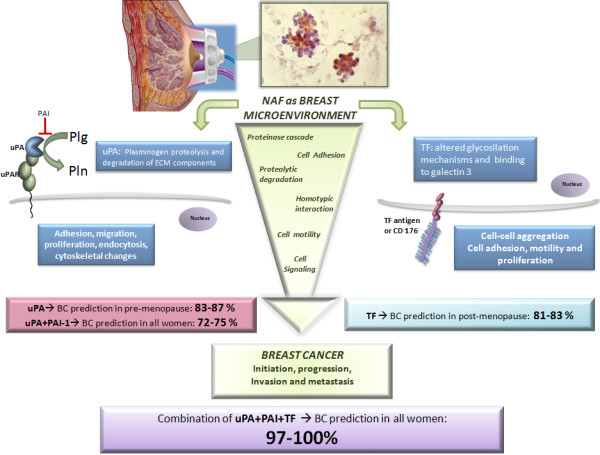Figure 1.

Nipple Aspirate Fluid (NAF), secreted by non-lactating women into the breast ductal system, represents a mirror of the breast microenvironment. NAF consists of secreted proteins and cells sloughed from stroma, ductal and lobular epithelium, containing several biomarkers that may be potentially useful tools. Several studies demonstrated implication of uPA-PAI system (on the left) and TF (Thomsen-Friedenreich) antigen (on the right) in several steps of breast cancer (BC) progression and metastasis through proteinase cascade activation, cell adhesion and motility. uPA (urokinase type Plasminogen Activator) is a serine protease whose main function is to catalyze the activation of plasminogen (Plg) into plasmin (Pln), after binding its receptor, uPAR (urokinase type Plasminogen Activator Receptor). Plasmin is able to degrade Extracellular Matrix (ECM), facilitating the release of several ECM components and proteolytic enzymes, leading to ECM remodeling and migration of BC cells. The uPA-PAI system activates signaling pathways promoting adhesion, proliferation and cytoskeletal changes in BC. The uPA physiological inhibition by PAI-1 (Plasminogen Activator Inhibitor 1) controls the activation of Plg into Pln and ECM degradation, modulating proliferation pathways. TF antigen (or CD 176) is a disaccharide constituted by the core 1 structure of O-linked mucin type glycans, which in normal cells is masked through glycosylation mechanisms. In tumors, various determinants can lead to alterations in O-glycosylation biosynthesis machinery, leading to the unmasking of TF antigen. Considering these candidate biomarkers individually, they provide incomplete prediction accuracy: in fact, uPA alone was predictive of breast disease only in premenopausal women (83–87%). TF alone was only predictive of breast disease in postmenopausal women (81–83%). It has been demonstrated that when TF+uPA+PAI-1 were combined, their predictive ability approached 100% allowing an excellent improvement of prediction of atypia or BC disease in women requiring surgery because of suspicious breast lesions.
